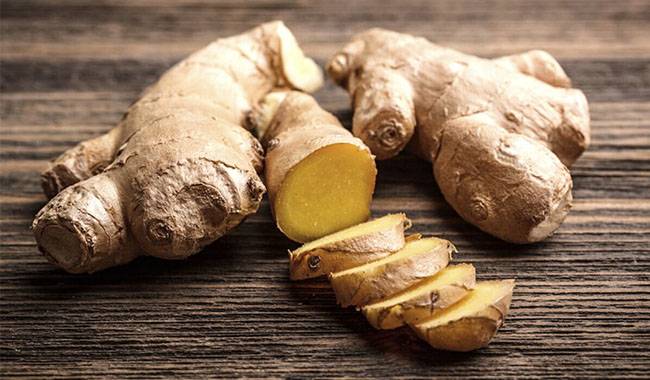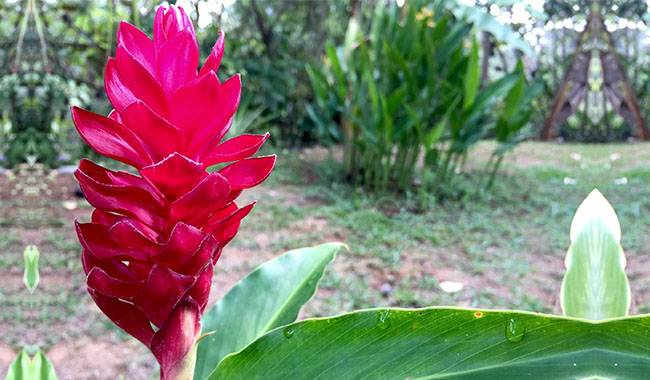
Ginger is a perennial plant that reaches a height of 40-80inch (1-2m). It has long, lance-shaped leaves and an erect stem. The rhizome is an underground storage organ that is palmately divided and covered with a thin black bark on top and a yellowish, fleshy pulp beneath with a slight, peculiar peppery flavor. It has small indeterminate leafy roots that extend downward and above-ground buds. Ginger is native to southern Asia but is now widely grown in Asia and Europe. It is cultivated outdoors in warmer regions and greenhouses and homes in cooler areas. This article describes how to grow ginger, as well as its ingredients and its applications in cooking.
Spiced ginger, or medicinal ginger, or common ginger (Zingiber officinale) a type species of the genus Ginger in the Ginger family (Zingiberaceae). In China, it is often referred to simply as ginger.
INTERESTING FACTS ABOUT GINGER
Translated from Sanskrit, ginger means “horny root” or, in another interpretation, “panacea.” In fact, it is used to treat 100 diseases. This natural aphrodisiac stimulates sexual desire, and for this reason, the Chinese associate ginger with the term “masculine energy.”
It is believed that people who drink ginger drinks become courageous, brave, and decisive. Fear, panic, and depression are unknown to such people. Clothes soaked in ginger oil will bring the owner all the success and wealth of his family business.
CHEMICAL COMPOSITION AND MEDICINAL PROPERTIES OF GINGER
The chemical composition of the rhizome determines its medicinal properties. The rhizome contains up to 3% of ginger essential oil, which has a peculiar aroma and contains a large number of macro and micronutrients. Among the amino acids, the chemical composition includes tryptophan, threonine, methionine, phenylalanine, valine, and others. Ginger contains high amounts of vitamins B, A, and C. The piquant flavor of ginger is imparted by gingerol.
Ginger’s constituents singulbene, camphor, bisphenolene, citral, and others combine with amino acids and other substances to form stable therapeutic complexes. Ginger root is used worldwide as a prophylactic and treatment for various diseases as an anti-inflammatory and antiseptic, choleretic, anthelmintic, anti-spasmodic, gastrointestinal disorders, and the liver. In East Asia, folk healers recommend ginger preparations to improve memory. It is considered to be a good natural stimulant for prolonging youth.
USING GINGER IN COOKING
The root of ginger is used as an ingredient or part of certain cold and hot dishes. Decoctions and infusions are used as treatments. In cooking, it is used to make preserves, beer (the famous ginger beer), add it to pastries and make sauces for meat dishes. Ginger tea is an indispensable remedy for colds and a light invigorator for physical labor and muscle fatigue. Having such a healthy herb in your home is a must.
THE SECRET OF GROWING GINGER
Thus, ginger can be grown anywhere, with one condition – prolonged high temperatures, sufficient humidity, in semi-mountainous areas (direct heat is destructive for the crop), without wind and strong winds. Experienced gardeners in some areas of the South grow ginger as an annual in small beds in the open ground. Under U.S. conditions, it is grown outdoors, in greenhouses and commercial farms, and as a house plant in pots and wide planters. All parts of ginger have a pleasant lemon scent. Consider several cultivation options for this valuable crop.
GINGER CAN BE GROWN OUTDOORS
To obtain fully grown rhizomes, ginger plants need to be in the ground for 8 to 10 months. Given its long growing period, it is best to propagate it as a seedling.
Preparing soil for ginger seedlings
Ginger likes moist air and does not tolerate over-watering. Prepare a 1:1:1 mixture of humus, mulch, sand, and light garden soil. You can purchase premixed humus at your local gardening store. The mixture should be well mixed and placed in a wide carrier or pot at least 10inch (25cm) in height and moistened.
At the end of February, place the ginger seedlings with shoots facing upwards in the prepared planting containers. Plant the rhizomes at 1-2inch (2.5-5 cm), cover with the soil mixture and water liberally. Remember! The drainage system is mandatory. 15-20 days later, young ginger shoots will appear.
Preparing rhizomes for planting
You can buy rhizomes for planting at shopping centers or in the vegetable department of stores. Planting material should be young (a must) and fresh. Young rhizomes have smooth bark, are light golden in color, and have small holes on the surface (similar to potatoes). Do not buy damaged, shriveled, sluggish or half-dried rootstocks. They will not come back to life and will not form shoots.
Soak the rootstock in the heated water for 12-20 hours before planting. During this time, the buds will swell slightly. Cut the planting material into several sections so that each section has 2-3 live shoots. It is best to cut along the ligaments of the rootstock buds. The surface of the wound should be protected from root rot and disease-causing fungi. This can be treated with bio fungicides, finely sieved wood ash, or crushed charcoal.
Preparing seedbeds for ginger seedlings
Ginger needs light to moderately acidic soil with a high organic matter content to develop successfully. In the fall, loosen the soil 10-12inch (25-30 cm) to create a soft bed. Apply 1-2 buckets of humus and 1 bucket of sand per 11 square feet. If the soil is nutrient-poor, add 50-80 g/11 sq. ft. of nitrocellulose. If the soil is heavy or dense, be sure to use coarse pebbles and sand or coniferous wood chips (which will acidify neutral soil) and chopped garden trimmings for a drainage substrate.
Planting ginger seedlings
Germinated rhizomes with asexually propagated shoots should be planted out permanently in April and May. To prevent unstable weather conditions (even in the south), cover the planting temporarily with film or other mulching material. The soil should be well moistened before planting. The planting scheme is rotational. The depth of the planting trench should be about 8inch (20 cm). Trenches can be covered with humus or mature humus. Spread the germinating seedlings at 12inch (30cm) intervals and cover with a layer of soil.
Taking care of ginger seedlings
After about 30-40 days, young shoots will appear on the soil surface. The green masses will grow very vigorously, and the plants need a lot of water in the soil and air. Spray the ginger plants 2-3 times a week with a watering can with a fine-mesh nozzle without letting the soil become too dry. The day after watering, loosen the soil to allow oxygen to better reach the roots. It is best to water and sprinkle before 9 a.m. and not before 3 to 4 p.m. so that the water droplets do not act as a lens and burn the plant’s leaves.
Fertilization of ginger
By forming rhizomes as storage organs, ginger is very responsive to fertilizers. Fertilizer is applied every 1.5 to 2 weeks, starting from the massive germination stage. Fertilizers are usually organic, alternating between cow manure and poultry manure at dilution ratios of 1:10 and 1:15. At the end of August, apply potassium sulfate for irrigation at a rate of 50-60 grams per 11 square feet. Potassium in this period promotes rootstock growth.
Harvesting ginger
If ginger was grown as an annual crop, stop watering as soon as the leaves begin to turn yellow and fall off. 1-1.5 weeks later (do not allow the soil to dry out too much), gently dig up the rhizomes and roots, taking care not to damage the crop. Clean off the soil and adventitious roots, wash off any dirt and dry gently in the sun or a dry, ventilated room.
Store the rhizomes in a cloth bag in a dry place or the vegetable compartment of the refrigerator. The optimal storage temperature is 35°F (2°C). Roots can also be frozen. Mature rhizomes should have a slight yellow tint on the cut side.
If ginger is grown as a garden ornamental, leave the roots in the soil over the winter. For spring plantings, place the rhizomes on the bottom shelf of the refrigerator.

GROWING GINGER IN THE UNITED STATES
Although ginger can be planted and grown year-round in tropical regions, cooler climates have a shorter growing season. Ginger can only tolerate temperatures above 50°F (10°C). In the United States, it can thrive year-round in zones 9 and higher. Florida, Southern California, Arizona, Hawaii, Southern Texas, and Louisiana have climates conducive to growing ginger year-round.
If you live in Zone 8 and lower, wait until after the last spring frost to plant ginger outdoors. Plant your ginger in pots so that if the temperature drops unexpectedly, you can easily bring it in.
Ginger usually takes 8 months to fully mature. However, those who live in cooler climates can harvest young ginger after 3 or 4 months or bring potted plants indoors during the winter.
HOME GROWING OF GINGER
In China, ginger is most commonly grown as an indoor annual ornamental and medicinal plant, even in the south. Rootstock can be planted at any time of the year, but dividers are more practical and better developed for winter planting.
The size of containers and other containers prepared for plants is very important in indoor cultivation. Pots, containers, tubs, and boxes should have a wide top because the branching root system with rhizomes is located at the surface. Containers should be 8-12inch (20-30 cm) high for annuals and 12-16inch (30-40 cm) high for perennials. Containers are placed on a pan filled with pebbles. If necessary, watering was done with a tray. Several holes were made in the bottom of the pot to allow excess water to escape in case of overwatering and when the soil becomes dry for various reasons. The soil is composed of humus or bio-humus, sand, and deciduous soil. Equal amounts are mixed and filled into containers. The prepared seedlings are placed in the top layer of the soil mixture and buried in a few inches. 15-20 days later, young ginger shoots will emerge. Further care is the same as in the greenhouse.
Young ornamentals should not be replanted for the first 2-3 years, but thereafter this procedure should be performed annually. Propagate ginger by dividing the rhizomes while transplanting. When transplanting, especially when dividing the roots, take all sanitary precautions to prevent disease-causing bacteria and fungi that may cause root rot. If grown at home as a perennial, ginger can reach a height of 40-60inch (1-1.5m). Under optimal growing conditions, ginger produces orange-yellow, sometimes red or brown flowers in short spikes. In winter, flowering is extremely rare. The plants recede when the vegetation above the ground partially turns yellow. During this period, the rhizomes are dug up and either used directly for homemade medicine or some of them are stored for spring propagation. Some amateur growers transplant the plants immediately by separating parts of the crop.
More Related Information About Planting & Growing Ginger Plants



